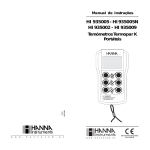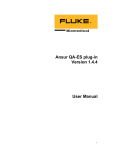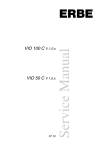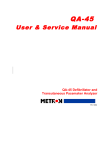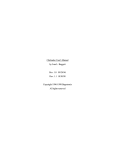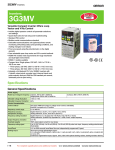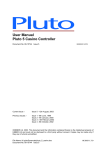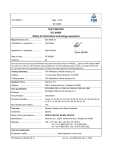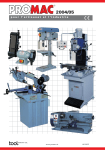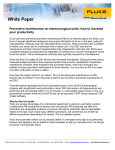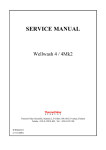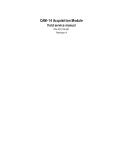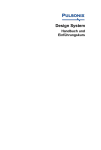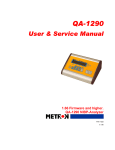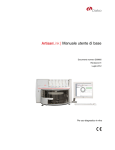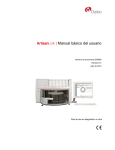Download User & Service Manual - Frank`s Hospital Workshop
Transcript
QA-ES User & Service Manual QA-ES Electrosurgical Analyzer P/N 14025 Copyright 2001 by METRON. All rights reserved. METRON: USA__ 1345 Monroe NW, Suite 255A Grand Rapids, MI 49505 Phone: (+1) 888 863-8766 Fax: (+1) 616 454-3350 E-mail: [email protected] FRANCE ________________ 30, rue Paul Claudel 91000 Evry, France Phone: (+33) 1 6078 8899 Fax: (+33) 1 6078 6839 E-mail: [email protected] NORWAY________________ Travbaneveien 1 N-7044 Trondheim, Norway Phone: (+47) 7382 8500 Fax: (+47) 7391 7009 E-mail: [email protected] Disclaimer METRON provides this publication as is without warranty of any kind, either express or implied, including but not limited to the implied warranties of merchantability or fitness for any particular purpose. Further, METRON reserves the right to revise this publication and to make changes from time to time to the content hereof, without obligation to METRON or its local representatives to notify any person of such revision or changes. Some jurisdictions do not allow disclaimers of expressed or implied warranties in certain transactions; therefore, this statement may not apply to you. Limited Warranty METRON warrants that the QA-ES Electrosurgical Analyzer will substantially conform to published specifications and to the documentation, provided that it is used for the purpose for which it was designed. METRON will, for a period of twelve (12) months from date of purchase, replace or repair any defective system, if the fault is due to a manufacturing defect. In no event will METRON or its local representatives be liable for direct, indirect, special, incidental, or consequential damages arising out of the use of or inability to use the QA-ES Electrosurgical Analyzer, even if advised of the possibility of such damages. METRON or its local representatives are not responsible for any costs, loss of profits, loss of data, or claims by third parties due to use of, or inability to use the QA-ES Electrosurgical Analyzer. Neither METRON nor its local representatives will accept, nor be bound by any other form of guarantee concerning the QA-ES Electrosurgical Analyzer other than this guarantee. Some jurisdictions do not allow disclaimers of expressed or implied warranties in certain transactions; there fore, this statement may not apply to you. ii Table of Contents 1. Introduction........................................................................................................................................1 2. Installation..........................................................................................................................................1 3. Operating QA-ES...............................................................................................................................1 4. ESU Tests with QA-ES......................................................................................................................1 5. Control and Calibration....................................................................................................................1 6. Component Functions and Parts......................................................................................................1 Appendix A – Diagrams ........................................................................................................................A-1 Appendix B – Error Report Form........................................................................................................B-1 Appendix C – Improvement Suggestion Form....................................................................................C-1 iii This page intentionally left blank. iv Manual Revision Record This record page is for recording revisions to your QA-ES User & Service Manual that have been published by METRON AS or its authorized representatives. We recommend that only the management or facility representative authorized to process changes and revisions to publications: • make the pen changes or insert the revised pages; • ensure that obsolete pages are withdrawn and either disposed of immediately, or marked as superseded and placed in a superseded document file, and; • enter the information below reflecting that the revisions have been entered. Rev No Date Entered Reason 1.30-1 4-30-01 General Update Signature of Person Entering Change v This page intentionally left blank. vi 1. Introduction This chapter describes the METRON QA-ES Electrosurgical Analyzer, including its features and specifications. 1.1 tion QA-ES DescripThe METRON QA-ES Electrosurgical Analyzer (QA-ES) is a precision instrument designed to perform tests on high-frequency electrosurgical units (ESU) in accordance with national and international standards, and is designed to be used by trained service technicians. Tests include: • • • • automatic power distribution measurement; crest factor measurement; RF leak measurement, and; return electrode monitor (REM) test Testing is accomplished by measuring the ESU output against test loads that are set and adjusted in the QA-ES. The QA-ES can automatically execute a power distribution test with a load resistance ranging from 10 ohms to a maximum of 5200 ohms. The automatic measuring of the QA-ES, comprising crest factor measurements with a bandwidth of 10 MHz, ensures that the test result is reliable and reproducible. Test results, shown in the QA-ES’s LCD display, can be printed out directly, or transferred to a PC via the PRO-Soft QA-ES test automation software. PRO-Soft lets you design test protocols, remotely control the QA-ES, and store the test results. 1.2 QA-ES Specifications Generator Output: RF LEAKAGE: From active electrode or neutral plate with an open or closed load circuit. Mode Of Operation: Manual or user-programmable. Can be remotely controlled with PC utilizing accessory PRO-Soft QA-ES software and RS-232 communication cable connection. Measurements: True RMS value of applied waveform. RMS Bandwidth: 30 Hz to 10 MHz (+3 dB). Low Frequency Filter: 100 Hz filter to avoid low frequency disturbance and/or interference. Current: 20 mA to 2200 mA. Current Accuracy: 20 - 2200 mA ± 2% of reading. Load Resistance: 10 - 2500 ohms in steps of 25 ohms (@ dc). 1 2600 - 5200 ohms in steps of 100 ohms (@ dc). Additional Fixed Load: 200 ohms, 500 watt maximum. Crest Factor: The higher of the two peak-measurements is used for calculation. Range: 1.4 - 16 (V peak voltage / V RMS). Foot Switch Output: The output triggers the measurement after a programmed delay time, defined as the time period from the activation of the foot switch to the beginning of data processing. The delay time is 200 ms - 4000 ms. Peak To Peak Voltage: 0 to 10 kV (closed load only) ± 10%. Measurement is taken between the active and dispersive electrodes with closed load only. Oscilloscope Output: 5 V/A uncalibrated, 100 mA RF current minimum input. Isolation: 10 kV isolation between measurement device and enclosure. 1.3 General Information Temperature Requirements: +15°C to +35°C when operating 0°C to +50°C in storage Display: Type Alphanumeric format Graphics mode: Display control: LCD graphic display 8 lines, 40 characters 240 x 64 point matrix 5 F-keys, enter, cancel and an encoder Data Input/ Output (2): Parallel printer port (1); Bi-directional RS -232C (1) for Computer control Power Source: From 115 VAC to 230 VAC, 48/66 MHz. Mechanical Specifications: Housing Metal case Height 13.2 cm / 4.48 in. Width 34.2 cm / 11.61 in. Length 39.5 cm / 13.41 in. Weight 9.8 kg / 21.6 lbs. 2 Standard Accessories: QA-ES Electrosurgical Analyzer Power Cord QA-ES User and Service Manual (P.N. 14010) (P.N. 14300) (P.N. 14025) Additional Accessories: E-Input Measuring Cable - Black (P.N. 11451) E-Input Measuring Cable - Red Alligator Clamp - Black Alligator Clamp - Red Carrying case PRO-Soft QA-ES software PRO-Soft QA-ES DEMO PRO-Soft QA-ES User Manual (P.N. 11452) (P.N. 11461) (P.N. 11462) (P.N. 14100) (P.N. 12200) (P.N. 14201) (P.N. 14225) Storage: Store in the carrying case in dry surroundings within the temperature range specified. There are no other storage requirements. Periodic Inspection: The unit should be calibrated every 12 months. 3 This page intentionally left blank 4 2. Installation This chapter explains unpacking, receipt inspection and claims, and the general procedures for QA-ES setup. 2.1 tion Receipt, Inspecand Return 1. Inspect the outer box for damage. 2. Carefully unpack all items from the box and check to see that you have the following items: QA-ES Electrosurgical Analyzer (PN 14010) E-Input Measuring Cable -- Black (PN 11411-B) E-Input Measuring Cable -- Red (PN 11411-R) Alligator Clamp -- Black (PN 11412-B) Alligator Clamp -- Red (PN 11412-R) Power Cord (No PN) QA-ES User and Service Manual (PN 14025) 3. If you note physical damage, or if the unit fails to function according to specification, inform the supplier immediately. When METRON AS or the company’s representative, is informed, measures will be taken to either repair the unit or dispatch a replacement. The customer will not have to wait for a claim to be investigated by the supplier. The customer should place a new purchase order to ensure delivery. 4. When returning an instrument to METRON AS, or the company representative, fill out the address label, describe what is wrong with the instrument, and provide the model and serial numbers. If possible, use the original packaging material for return shipping. Otherwise, repack the unit using: a reinforced cardboard box, strong enough to carry the weight of the unit. at least 5 cm of shock-absorbing material around the unit. nonabrasive dust-free material for the other parts. Repack the unit in a manner to ensure that it cannot shift in the box during shipment. METRON’s product warranty is on page ii of this manual. The warranty does not cover freight charges. C.O.D. will not be accepted without authorization from METRON A.S or its representative. 2.2 Setup 1. Equipment connection is as shown in the typical setup below (for Power Distribution Test). 1 CAUTION The QA-ES uses a 3-wire power cord and plug for the user's safety. Use this power cord in conjunction with a properly grounded electrical outlet to avoid electrical shock. 2. If you are using an oscilloscope, attach the BNC cable to the Scope Output connector, located on the front of the QA-ES. 3. If PRO-Soft QA-ES is being used, attach an RS-232 (null modem/data transfer configured) cable to the 9-pin D-sub outlet port located at the rear of the QA-ES. Do not attach the printer cable to the QA-ES. See below. However, if you are not using PRO-Soft QA-ES, and are sending directly to a printer for printouts, attach the printer cable to the 25-pin outlet port. 2.3 PRO-Soft QA-ES PRO-Soft QA-ES is a front-end test automation and presentation tool for METRON's ESU Performance Analyzer. It allows you to conduct the same tests, but by remote control via an IBM-compatible PC/XT with MS Windows (Version 3.1 or later). Additionally, the program has features to enhance your QA-ES’s performance. Each of the QA-ES tests can be run independently from PRO-Soft in the “Manual” test mode. Results are shown on the PC screen during testing, and the user is prompted to set the tested equipment accordingly. At the conclusion of tests, the user may print a report, store the test and results on disk, or both. Combinations of tests can be created and stored as “Test Sequences.” The program maintains a library of these sequences. In this way you can store and retrieve se- 2 quences that are appropriate for each ESU being tested at your facility. NOTE PRO-Soft QA-ES has its own user manual, which contains all the information concerning the program. If you order a demonstration version of the program you also receive the manual. Sequences can then be used independently, or can be attached to a checklist, written procedure, and equipment data in the form of a test “Protocol.” The equipment data can be entered manually into the protocol, or it may be retrieved by PRO-Soft from a database program, or other equipment files. Protocols can be created easily for each ESU in your inventory, and stored for use. Test protocols with results can be printed, or stored on disk, and the results of testing can be sent back to the equipment database to close a work order and update the service history. 3 This page intentionally left blank 4 3. Operating QA-ES This chapter explains the operating controls, switches and menus of the QA-ES, and details how to use them in ESU testing. 3.1 Control Switches and Connections Front Panel 1. Power Switch Turns the power on and off. 2. Encoder 3. Enter Sets values according to the specified range and choose between different operations/ measurement ranges. Admits newly specified information. 4. Cancel 5. LCD Display 6. Function Keys 7. RF-Detect 8. Remote 9. Scope Output Connector Cancels a new value and returns to previously chosen value. Shows messages, test results and function menus. Fl - F5 are used to select the functions shown on the bottom line of the LCD display, i.e., for selecting the function that is directly above the key. Indicates when the ESU is activated. Indicates that REMOTE CONTR. (F4) has been pressed. BNC-cable connector for attenuator signal in real time. (When oscilloscope output is desired.) 1 Right Side Panel 10. Terminal RED and BLACK Connection for the electrode outputs of the VAR. LOAD ESU. Active electrode to the red terminal, and neutral electrode to the black terminal. Additional fixed load resistance of 200 ohms FIXED LOAD 500 watt for serial connection during leakage test. Foot switch output switch can be used to trigger the ESU. 11. Terminal BLUE and BLUE 12. Terminal GREEN and GREEN 13. RS-232 Serial Port 9-pin D-sub 14. Printer Outlet Port 14-25 pin D-sub 15. Main Connector 3-pin SCHUCO-plug 16. Voltage Selector 115 VAC/230 VAC 17. Fuses T 200 mA @230 VAC / T 400 mA @ 11 5 VAC Rear Panel 2 3.2 QA-ES Menu and Function Keys The QA-ES uses a display, programmable function keys and a setting regulator to provide flexibility and control over the operations. The upper part of the screen displays messages, status and results. The menu bar is at the bottom of the display. The function keys are numbered from Fl to F5. A function is selected by pressing the key located directly under the Menu Item displayed in the menu bar. 3.3 LCD Display Menu/ Messages (Overview) 3 3.4 Menu/ LCD Display Messages (Detail) 1. Startup Screen. The following screen will be displayed for 2 seconds after the QA-ES has been switched on. 2. Main Menu a. First Menu Bar (Page 1) b. Second Menu Bar (Page 2) 3. SHOW CHOICES (F1). This function is activated when you see an asterisk (*) in the status field under ‘Mode.’ Choose a test function by pressing UP (F2) or DOWN (F3). (The encoder can also be used for choosing a test function) Press ENTER (F5) to save it under Mode in the STATUS field. Press CANCEL (F4) to undo. 4. KNOB PARAM. (F2). With this function, you can choose between ‘Mode,’ ‘Load’ and ‘Delay’ in the STATUS field. (* marks the active item). If you choose ‘Load’, use the encoder to set the load from 10 ohms to 5200 ohms in steps of: 25 ohms from 50 ohms to 2500 ohms. 100 ohms from 2500 ohms to 5200 ohms. Save the selected load in ‘Mode’ under the STATUS field by pressing ENTER (F5). Press CANCEL (F4) to undo. If you choose ‘Delay’, use the setting regulator to set the delay from 200 ms to 4000 ms in steps of: 50 ms from 200 ms to 1000 ms. 4 100 ms from 1000 ms to 4000 ms. Save the chosen delay in ‘Delay’ under the STATUS field by pressing ENTER (F5). Press CANCEL (F4) to undo. 5. START (F3). When you press on START, the test procedure will begin, and the text in the field ‘Oper.’ will change from ‘Ready’ to ‘Measuring’. If the unit is set to the position for a REM test, this text will change from ‘Ready’ to ‘lncr'. res.’ Press STOP (F3) to stop the test procedure. 6. SETUP (F4). Here you can set the power distribution level for start, stop and step in ohms. Choose the ‘Start load’ by using KNOB PARAM (F4). (see stars). Use the encoder to set the level. Save the level by pressing ENTER (F5). Press CANCEL (F4) to undo. Go to ‘End load’ and ‘Step Size’ and repeat the same procedure. Pwr. distr. Start load is the first load to be used during the measurements; it can be set from 10 ohms to 2100 ohms, with steps of 25 ohms starting at 25 ohms onwards. Pwr. distr. End load is the last load used in the measurements; R can be set from 525 ohms to 5200 ohms, with steps of 25 ohms from 525 to 2500 ohms and step of 100 ohms from 2500 ohms to 5200 ohms Pwr, distr. Step Size is the load set with steps of 25, 50, 100, and 200 ohms Press QUIT MENU (F5) to return to the main menu. 7. PRINT HEADER (F3). Writes a heading for a new test protocol. 8. REMOTE CONTR. (F4). Enables you to control the QA-ES through a PC. Required software: PRO-Soft QA-ES. 5 3.5 Printout Press PRINT HEADER (F3) before printing out a page if you want it to have a new heading. The QA-ES automatically prints out the test results via the printer output after every measurement. See example below. 3.6 Foot Switch Output A Foot Switch Output is activated by use of relays (K11), and located on the right side of the unit. This is used to trigger the foot switch input on the ESU being tested. 3.7 Main Switch On/Off The QA-ES has to be turned off for at least 5 seconds before turning it on again to allow the reset circuit to unload. 6 4. ESU Tests with QA-ES This chapter explains the tests that can be conducted by the QA-ES on an ESU, as well as the features available with the PRO-Soft QAES software accessory. 4.1 Power Distribution This test checks the power provided by the ESU over a range of load resistances. The QA-ES allows you to specify a range of loads, over which you test the ESU output power to see if it is within the specified limits. Per IEC 601-2-2 the power output cannot be reduced by more than 10W, or 5% of the minimum power output level. Per ANSI/AAMI HF18-1993 the power output must be within 20% of the ESU manufacturer’s specifications. Load Resistance Range Equipment IEC ANSI/AAMI Monopolar 100 - 1000 ohms 50 - 2000 ohms Bipolar 10 - 500 ohms 10 - 1000 ohms Test setup for ESU power distribution test: 4.2 HF Current Leakage This test checks to see whether or not the active and dispersive leakage currents are within acceptable limits. There are four test setups to accomplish this testing. Per IEC 601-2-2 and ANSI/AAMI HF18-1993 the ESU shall be operated at the maximum output setting in each operating mode. The limits for the acceptable leakage currents depend upon the test configuration. Test Configuration Limits of Acceptable Leakage Current Measured on electrodes The leakage current should not exceed 150 mA 1 Test Configuration Limits of Acceptable Leakage Current Bipolar The leakage current should not exceed 1% of the maximum bipolar rated power output. Measured at equipment terminals The leakage current should not exceed 100 mA. 1. Grounded HF Equipment: Measurements of the HF current leakage. The ESU is grounded. The test load is 200 ohms and the ESU must be operating at maximum power. The current leakage measured directly at the instrument's terminals must not exceed 100 mA. Test setup in compliance with IEC 601.2.2, sec. 19.101a, test 1, fig. 102 and sec. 19.102. (Adopted by ANSI/AAMI HF181993) Test setup in compliance with IEC 601.2.2, sec. 19.101a, test 2, fig. 103 and sec. 19.102. (Adopted by ANSI/AAMI HF18-1993) 2. HF Isolated Equipment: Measurements of the HF current leakage from the active and neutral electrodes. The test load is 200 ohm and the ESU must be operating at maximum power. The current leakage measured directly at the instrument's terminals must not exceed 100 mA. Active electrode test setup in compliance with IEC 601.2.2, sec. 19.101b, fig, 104 and sec. 19.102. (Adopted by ANSI/AAMI HF18-1993) 2 Neutral electrode test setup in compliance with IEC 601.2.2, sec. 19.101b, fig, 104 and sec. 19.102. (Adopted by ANSI/AAMI HF18-1993) 4.3 REM Alarm This test ensures that the ESU will sound an alarm if the resistance between the two neutral electrodes exceeds your specified limit. The program directs the OA-ES to gradually increase the resistance. At a certain value, the ESU should sound an alarm. Test setup for ESU REM alarm test. 3 This page intentionally left blank 4 5. Control and Calibration This chapter explains the QA-ES maintenance procedures, including testing and calibration. 5.1 Required Test Equipment ESU, 200W in 75 ohms with 500 kHz Signal generator, 3 MHz, harmonics better than -40 dBc with 500 kHz, 0 dBm Digital multimeter Digital multimeter, HP 34401 or equivalent RMS / Peak Voltmeter, RHODE & SCHWARY URE 3 or equivalent Oscilloscope, 10 MHz Electrosurgical probe for QA-ES Computer (PC) with RS-232C interface Printer with parallel interface Short circuit SMB terminal, female Test cables 5.2 Preparation WARNING! HIGH VOLTAGES ARE CAPABLE OF CAUSING DEATH! USE EXTREME CAUTION WHEN PERFORMING TESTS AND CALIBRATION. USE ONLY INSULATED TOOLS WHEN THE UNIT IS PLUGGED IN, AND THE CASE HOUSING IS OFF. The QA-ES should be switched on for a minimum of 15 minutes before the test starts to ensure stable working temperatures. Before performing testing and calibration, you must dismantle the housing. This is accomplished by removing the side plates fastened with Velcro straps. Then, remove the bottom plate by loosening the four screws. Afterwards, move the bottom plate of the isolation box by loosening the 16 screws holding it in place. Adjust the voltage switch at the rear of the QA-ES so that is corresponds to the main voltage (115 or 230V). 5.3 Function Testing 1. Power Supply. Connect the multimeter in series on one of the mains supply leads to measure the current consumption. Turn Measurements should be performed only on main supply, and not both 230V and 115V. 1 on the QA-ES. Don't activate any functions. Measure the current. Required value: 230±10%: 80mA -10/+20mA 115±10%: 160mA -20/+40mA 2. User Interface and Display. Check that the display and the user interface are working normally. 3. Cooling Fan. Check that the fan increases speed when you press on Start (F3) in the main menu and that the speed decreases about 10 seconds after you press STOP (F3). 4. Serial and Parallel Interface. QA-ES can be connected to a printer and a PC. Check that booth the serial and parallel interfaces work. 5. Foot Switch. Connect a multimeter to the foot switch output on the QA-ES (green). Check that the relay for the foot switch is connected when you press START (F3). 6. Fixed Load. Measure the value of the fixed load with a multimeter (blue). Required value: 200 ohms ±10 ohms. 7. Housing Isolation. Use a multimeter to check the isolation between the housing and the measuring inputs. It is important to check all of the terminals on the housing: ‘Var. Load', 'Fixed Load' and 'Foot Switch’. 1. Offset Voltage. Short-circuit the RF input on the sampling unit (J4). All the measurements and reference values in this section refer to the sampling unit. Measure the voltage at each of the following points and adjust them to the following values with the potentiometers specified between brackets. The voltage should be set as close to 0V as possible. 5.4 Calibration TP1 - GND (no adjust) OmV ∀100 ΦV TP4 - GND (R2) O ΦV ∀100 ΦV TP5 - GND (R1) O ΦV ∀500 ΦV TP6 - GND (R4) OmV ∀5 mV 2. Load Resistance. Set the QA-ES in calibration mode by holding the function key F1 while switching the instrument ON. Continue to press on the key until the main menu appears. Connect a multimeter (hp 34401A) to the 'Var. Load' input. The resistances are calibrated by turning the small wheel until the display shows a value as close as possible to the value read. To calibrate the next resistance, press on UP (F1) or DOWN (F2). 3. Measuring Resistance. Set the QA-ES in calibration mode. Before mounting it, the measuring resistance R1 on the Load Board should be measured with hp 34401A. The measured value should be noted near R1 on the Load Board. Use this value for R1 in the following equation and for ‘Meas. Reas.’ in the calibration menu by using the wheel. Press QUIT (F5) to save calibrated values. It is important to calibrate the resistance of the measuring leads on the multimeter itself before starting the test. 2 TP3 - TP2 (R3) O ΦV ∀50 ΦV Meas Re s = 4. R1 * 100 R1 + 100 Measuring Device Measuring The Effect. Set the QA-ES in test mode by holding F2 while switching the power on. Connect the signal generator to the RF input on the sampling unit. The signal applied is a pure sine of 500 kHz. URE 3 is connected in parallel with the sampling unit to measure the applied signal. Press START (F3) and read the measured effect in dB. Vary the level of the applied signal from -16 dBm to +10 dBm and find the average value for the difference between the value read on the QA-ES and the applied value measured with URE 3. Use the term below to calculate a linear percentage value from the difference value in dB. KdB: Average value for the difference between the value read on QA-ES and the applied value measured with URE 3. kdB Clin = 10 20 Clin: Linear value of kdB. Q gain = Q gain • Clin The following term will lead to a new value for Q_gain. Turn the wheel and press ENTER to specify a new value for Q_gain. Repeat the test until the average value between the QA-ES and URE 3 is smaller than 0.1 dB. This corresponds to an error of 2.3%. Peak Detector. Once the measuring device used in measuring the effect has been calibrated, you can calibrate the peak detector. Use the same test setup as for calibrating the effect. Measure with a signal level of 200 mVp and 1 VP applied from the generator. The applied amplitude is measured with URE 3. The difference between the value read on the QA-ES and URE 3 should not exceed 10% otherwise the P_offset and N_offset in the calibration menu must be changed until this requirement is met. If the positive peak value read is too small P_offset should be reduced. N_offset should be reduced if the negative peak value is too low. Press QUIT (F5) to save calibrated values. 5. Measuring Accuracy of the total system. Connect the coaxial cable from the Load Board to the RF-input (J4) on the Sampling Unit. Put the ground plate of the isolating box back into place. Connect a high voltage probe in the port for variable load resistance on the QA-ES. The probe's coaxial cable should be connected to URE 3. The banana adapters of the probe are connected with the high voltage generator. The following mathematical formula presents the applied effect in dBm as a curve of the effect on URE 3. 3 R1 + R 2 dBcoeff = 20 • log R2 R1: Resistance in the high voltage probe. Specified on the probe. Nominal value 47 kohms. Pm − PURE# + dBcoeff R2: Measuring resistance in the high voltage probe. Speci- fied on the probe. Nominal value 37.5 ohms. The measuring accuracy of the QA-ES should be checked for the following resistance values and the corresponding signals applied. R Applied signal measured on URE3 NOTE [ohms]Remember to [W] [dBm] set the reference impedance 75 52.0 - 54.0 200 ∀ 50W in the same value 300 URE 3 to 150 50.0 - 53.0 ∀ 50 W as the load resistance 1500 used for measuring. 47.0 - 52.0 100 ∀ 50 W Calculate the average value for the difference between QA-ES and URE 3 and correct the value for Q_gain in the calibration menu by following the instructions given before under item 4 in this section. Requirement: . dB P m[ [dBm] − Pqa − es [dBm] < 017 I qa − es > 50[mA] In linear form this corresponds to: Pm − Pqa − es < 4% Pm 6. Remember that the scope output is not calibrated! Scope Output. Connect the high voltage generator to 'Var. Load' and the oscilloscope to 'Scope Output'. Set the QA-ES to continuous mode and start measuring by pressing on Start. Activate the high voltage generator and measure the peak-to-peak voltage on the oscilloscope. Check that this value equals the current flow read on the QA-ES. Nominal value: 4 4.5 ∀ 0.4 V/A 6. Component Functions and Parts This chapter provides a detailed description of the functions of the main components of the QA-ES, as well as a parts list for cross-reference. Reference is made to the component location and schematic diagrams to assist servicing personnel. These diagrams are foldouts, and are located in Appendix B. 6.1 Processor Board (Refer to QA-ES Processor Board Component Location Diagram and Schematic Diagrams 1 and 2) The Processor Board is installed on the inside of the front plate. It comprises the: power supply; microprocessor system; display; function keys; interface towards Sampling Unit, and; RS 232 port and printer port The Processor Board activates and controls the sampling procedure in the QA-ES. The data is routed back from the Sampling Unit to the microprocessor, where the results will be calculated before being displayed. 1. Power Supply (See QA-ES Processor Board Schematic Diagram 2). The Processor Board receives 12 VAC from the Transformer located at the rear of the QA-ES via J4. The voltage is then converted with diode D9 and filtered through C1. Voltage regulator U8 supplies the circuits with +5 V. The voltage is adjusted with resistors Rl0 and R11. Schottky diode D4 protects the 5V power supply to the printer interface to avoid any power flow between the printer and the Processor Board while the QA-ES is switched off. Capacitive switch regulator U9 generates -12 V from +12 V. V-comparator U10 monitors the +5V voltage and sends a reset signal to the microprocessor when the voltage drops under 4.75 V. Transistor Q4 controls the voltage to the compressor at the rear of the QA-ES. The compressor is connected to J5. The microprocessor issues a digital signal at PWMA, depending on the ventilation speed desired. Transistor Q2 controls the basic power in Q4. When Q4 is turned off (low ventilation speed), the compressor receives power via transistors R8 and R17, leading to a voltage drop. 2. Microprocessor System 1 (See QA-ES Processor Board Schematic Diagram 1). The microprocessor system is in PCMCIA card format (U1). It comprises a MC68HC16 microprocessor with I/O, 256K Flash ROM and 64K RAM. It can be reprogrammed or replaced when upgrading the software. The processor's I/O includes an asynchronous serial port (ACIA), synchronize serial port, parallel I/O, A/D converter and PWM output. In addition, 8 bit of the data bus are accessible, as well as chip-select lines for direct access to the external I/O. The processor is timed with a 16.67 MHz timer frequency, controlled by an internal crystal in the component. To check the timer frequency, a 1024 Hz square signal is applied to one of the PWM outputs. The signal can be measured at pin TP 1. Ul3 is an EEPROM connected to the processor component via a parallel I/O. Ul3 saves the calibration parameters for the Sampling Unit. The parameters can be stored independently of the processor component so that the QA-ES does not have to be recalibrated when upgrading the software. 3. Function Keys (See QA-ES Processor Board Schematic Diagram 1). The QAES is operated by touch keys and a universal digital encoder. The encoder, or 'knob', will be given different functions depending upon the parameters that are to be changed. The encoder is connected to two touch keys with unchangeable functions, 'ENTER' and 'CANCEL'. The QA-ES is operated from 5 'soft-keys' linked to menus shown on the display. Latch U2 buffers data from touch keys SW1-SW7. If you press one of the keys, power will flow into the base at Q1 via RP1, thus controlling an interrupter input on the processor unit. When the interrupter input is activated the processor reads latch U2 latch to find out which key was pressed. The same interrupter input is activated via diodes D1 and D2 when operating the encoder. The encoder is read via I/O ports on the processor component. 4. Display (See QA-ES Processor Board Schematic Diagram 1). The QAES is equipped with a 240 x 64 dot graphic display with a builtin character generator. When in character mode, the display shows 40 x 8 characters. The display is controlled by the processor unit via the data bus. The display's contrasting voltage is regulated with voltage regulator U12. Voltage (and contrast) are controlled with the potentiometer R15. This is the only point of adjustment at the processor board. The display offers EL background light to make it easier for the user to read. U11 is an oscillator generating an operating voltage of about 90 VAC for the EL component. 5. 2 Interface Towards Sampling Unit (See QA-ES Processor Board Schematic Diagram 1). All data transferred between the Sampling Unit and the Processor Unit is in serial format to simplify the optical interface on the sampling board. Communication is controlled by the synchronous serial interface on the processor unit. The signals are transmitted via pin board base J1. 6. Serial Port (See QA-ES Processor Board Schematic Diagram 2). The serial port is adapted to a 9-pin RS-232C format. The port is set to 9600 baud, 8 data bits, 1 stop bit and no parity. RS-232 driver U6 drives the data signals. The handshake is software-oriented. The command responses are returned via the D-sub terminal. 7. Printer Output (See QA-ES Processor Board Schematic Diagram 2). The Processor Board’s printer output has a standard 25-pin D-sub contact for Centronix interface. The output is built around 3 HCMOS circuits; U3, U4 and U5. The circuits are connected to the data bus and I/O ports of the processor unit. U3 is a latch for the 8 parallel data lines. U4 is the driver for the outgoing commands, while U5 acts as a buffer for incoming commands. RP3 comprises pull-up resistances for the input lines. All signals to the printer output are filtered to reduce high frequency radiation. 6.2 Sampling Unit The QA-ES Sampling Unit is placed inside the internal protection box of the instrument. The card is fixed vertically on the right side of the protection box. The unit comprises: power supply; measuring device, and; interfaces towards the Processor Board and the Load Board. The Sampling Unit converts the applied RF signal to a low frequency signal proportional to the mean square of the RF signal. The peak value of the applied signal is also measured. The measuring values are sampled with a 12 bits A/D converter and the data is transmitted to the Processor Board for calculation and presentation on the display. 1. Power Supply (See QA-ES Processor Board Schematic Diagram 1). The Sampling Unit receives -10 VDC and +10 VDC from the Load Board via J1). Voltage regulators U17 and U19 provide, respectively, +6V and -6V for the RMS DC converter. Voltage regulators U18 and U20 provide the peak detector with +9V and -9V. Voltage regulator U16 supplies the opto-coupler in the interface towards the Processor Board with + 5V. 2. Measuring Device 3 The measuring device consists of two blocks: • • a RMS DC converter for current measuring, and; a peak detector for measuring the peak voltage in the signal. The peak detector is divided into two actions for measuring the positive and negative peak values. 3. Input Filtration At the measuring system input, the incoming signal is filtered down to a lower level through a filter based on L1, L2, C5, C6 and C7. The 3dB frequency is set to 10 MHz. The filter can be found on diagram 1 of 3. 4. RMS DC Converter (See QA-ES Processor Board Schematic Diagram 1). The RMS DC converter is based upon an analog multiplicator from analog devices AD834, U15. U15 and U25 form a circuit that calculates the mean square of the applied signal. A filter, consisting of C8, C9. C50, C51, R35 and R36, determines the constant time factor for the integration, which will correspond to the amplitude of the outgoing signal at U25. Further calculations of RMS values and current are carried out in the software on the Processor Board. Two amplification steps following the mean square circuit ensure optimum dynamics in the measuring system. Both steps U13 and U14 provide 20 dB amplification. By measuring the signal before U13, and after U13 and U14, you can determine which signal level makes the best use of the A/D converter dynamics. 5. Peak Detector (See QA-ES Processor Board Schematic Diagram 3). The peak detector is divided into two sections: one for detecting the positive peak voltage, and the other for detecting the negative peak voltage. The detector is based on a transistor diode connection. The positive peak voltage is detected by transistors Q1 and Q4, to which are attached various components. The same goes for the negative peak voltage with Q2 and Q5. The positive peak voltage is built up over the C27 capacitor, whereas the negative peak voltage is built up over the C28 capacitor. U23 drains small amounts of current from C27, and provides the AID converter with correct polarization and low impedance for the positive peak detector. U22 does the same for the negative peak detector. The peak detector ran be reset by short-circuiting C27 and C28 via octol analog switch U24 (See QA-ES Processor Board Schematic Diagram 2). 6. 4 A/D Converter The measuring device uses a 12-bit A/D converter from linear, Ul. This circuit measures both RMS values, and positive and negative peak voltage. Each of the signals is multiplexed into the A/D converter via the U24 switch. The sampling speed depends on the Processor Board's reading speed. Schottky diode D7 protects the A/D converter from incoming negative signals. 7. Interface Towards Load Board and Processor Board The measuring device and load resistances in the QA-ES are isolated from the processor unit and the housing by a galvanic shield. This protects the user if a fault in the QA-ES produces ground currents during the measurements. This interface is based upon opto-couplers and various mains transformers for the user interface and the measuring device in the QA-ES. Data is transferred digitally between the Sampling Unit and the Processor Board in serial form via J3 to simplify the optical interface. Opto-couplers U5, U6, U7 and U8 are used in transmitting signals from the processor system to the Sampling Unit. The Opto-coupler U9 transfers the measurement from the Sampling Unit back to the processor system on the Processor Board. The relays used in choosing load values on the Load Board are also controlled via terminal J3 on the Sampling Unit. The commands are then transmitted from the Sampling Unit to the Load Board via terminal J2. 8. High Voltage Protection Diodes D8-D15 are a protection device against high voltage signals entering the Sampling Unit. 6.3 Load Board (Refer to QA-ES Load Board Component and Schematic Diagrams). The Load Board is located inside the internal protection box in the QA-ES. The card is fixed vertically inside the box. The unit includes a power supply, load resistances with corresponding control relays, and interface towards the processor system Sampling Unit, a measurement resistor with attenuators and measuring Transformer for the scope output. The Load Board forms the load for the ESU being tested. The load can vary from 10 ohms to 5200 ohms, or be fixed to 200 ohms. A high voltage relay inside the Load Board (K1) connects the load to or from the ESU. 1. Power Supply The Load Board is supplied with 2 x 9 VAC from the Trafo in the front part of the protection box via J14. The voltage is converted with diode D9, and filtered through Cl and C2. U1 is a voltage regulator, providing the relay drivers +5 V. U1 also supplies Sampling Unit opto-couplers U10, U11 and U12 with 5 5 V. Cl and C2 provide relay drivers U2 and U3 with +10 VDC and -10 VDC. These voltages are used for controlling the relays on the Load Board. 2. Load Resistances There are two load resistances on the Load Board, seen from the ESU being tested. The first has a fixed load of 200 ohms, and is used to measure the current leakage. The other is a variable load resistance, which varies in steps of 25 ohms, from 10 ohms to 5200 ohms. 3. Fixed Load Resistance The fixed load resistance is based on the two 100 ohms non-inductive resistances (R17 and R18) connected in series. The total load can be 350 W continuously. 4. Variable Load Resistance The variable load resistance is also based on a non-inductive resistance (R3 - R16). In addition, relays (K2 - K10) have been used to offer the choice between different combinations of resistances. You can therefore obtain any value between 10 and 5200 ohms. 5. Measuring Resistance and Attenuator The measuring signal transmitted to the Sampling Unit is drained over a 2.0 ohms resistance (R1) in series with the variable load resistance (R3 - R16). Before the signal is transmitted to the measuring device, it passes through a variable attenuator, based on a 10 dB attenuator (R20 - R22) and a 20 dB attenuator (R26 - R30). By connecting these attenuators in series, you can obtain an attenuation of 30 dB. 6 6. Interface Towards Sampling Unit When the signals pass through an optical barrier between the processor system and the rest of the electronics, the Sampling Unit's F1 terminal controls the relays, choosing the load and attenuator values on the Load Board. 7. Scope Output The scope output is based on a measuring Transformer L1, mounted on the Load Board. The measuring Transformer is terminated with a 50 ohms resistance R31. 8. Foot Switch The output foot switch is based on a relay (K11), and is used in triggering the ESU being tested. 6.4 Component Parts COMPONENT PART TYPE/VALUE HOUSING: Transformer ring core 1x12V 1A Transformer E-core 10kV 2x9V D-Sub 25p female D-Sub 9p male Flat cable contact 10-polt Flat cable contact 16-polt Flat cable contact 26-polt BNC Straight bulkhead jack SMB coax. conn. Straight plug Security contact Red Security contact Black Security contact White Security contact Green Ventilator 12 VDC 92mm Protection grate for ventilator Turning knob Voltage regulator Apparatus input with netfilter Safety fuse 5x20 mm Safety fuse 5x20 mm Net switch Cable shoe ABIKO Ring cable shoe Screw dimension M3 Flat cable Flat cable to printer Flat cable to serial port Flat to measuring board Coax. cable IRG174 Countersunk flat headed screw Countersunk flat headed screw Screw slot SH Screw slot SH Screw slot SH Screw slot SH Screw recessed head poz Screw recessed head poz Screw recessed head poz QTY. DIAGRAM REFERENCE 1 ULVECO AA81002 ELTRAFO ELFA 43-674-54 ELFA43-673-97 ELFA 43-646-00 ELFA 43-646-26 ELFA 43-646-42 R141306000 Rl14082000 Flat 4.8mm JHSupp 404-171 Flat 4.8mm JHSupp 404-137 Flat 4.8mm Flat 4.8mm Panasonic FBA09A12H1A Sunon FG-9 C&K V802-12-SS-05-Q Corcom lED4 Schurter 0031.1081 FEF Schurter 0031.1363 FIO C&K DM22-J1-2-S2-05-N-Q 25-polt 44 cm 9-polt 44 cm 16-polt 33 cm 45 cm Farn 125326 DIN 965 M4x12 DIN 965 M3x6 DIN 84A M3x10 DIN 84A M3x8 DIN 84A M4x10 DIN 84A M4x35 DIN 7985 M2-5x10 DIN 7985 M3x6 DIN 7985 M3x8 1 1 1 1 1 2 1 1 1 1 1 2 2 1 1 1 1 1 2 2 1 13 1 1 1 1 1 1 14 8 4 12 4 1 8 31 4 7 COMPONENT PART TYPE/VALUE Screw recessed head poz DIN 7985 M3x10 Screw recessed head poz DIN 7985 M4x30 Nut M3 Nut M4 Safety nut M4 Spring washer M4 Washer M4 12mmø DIN 9021 Spacer for fixing the front plate Contact plate RF protection box Front plate w/5 screws for circuit board Rear plate Front foilv QTY. DIAGRAM REFERENCE 4 4 6 4 1 4 1 5 1 1 1 1 1 PROCESSOR BOARD: Printed circuit board Micro Module Latch Port RS 232-driver Voltage Reg. Voltage Reg. V-converter V-comparator V-converter EEPROM Transistor Transistor Diode Diode Schottky diode Bridge LCD-display Encoder LED LED Resistor Resistor Resistor Resistor Resistor Resistor Resistor Resistor Resistor Resistor Resistor pack Resistor pack Resistor pack Resistor pack Varistor Trimpot Multilayercond. El.lytt cond. El.lytt cond. El.lytt cond. Tantal cond. EMI-Filter PCM-ClA slot Display-connection 8 Elprint AR075 16MM16 74HC574N 74HC05N MC145406P LM337LZ LM317T ICL7662CPA Mc34064P-5 NeI-D32-49 X24C02P BC547B BD140 1N4148 1N4002 1N5819 4A 200v Optrex DMF 5005N-EW Bourns ECWIJ-B24-BC0024 Gul 3mm Sie LY3360-K Rød 3mm Sie LR 3360-FJ 22R 1% 0.5W 240R 1% 0.5W 330R 1% 0.5W 750R 1% 0.5W 1K0 1% 0.5W 2K2 1% 0.5W 6K8 1% 0.5W 10K 1% 0.5W 22K 1% 0.5W 100K 1% 0.5W 5x2K2 SIL 8x4K7 SIL 8x10K SIL 8x47K SIL 20V 10K 1-tørn Cermet 100nF 50V 10 F 25V 220 F 25V 2200 F 25V 1 F 35V Murata DSS306-91YSS102M1 4 pin Berg 71991-410 1 1 3 1 1 1 1 1 1 1 1 2 1 4 1 1 1 1 1 1 1 2 1 2 1 1 1 1 5 2 1 1 1 1 1 1 1 6 4 1 1 1 19 1 1 U1 U2, U3, U5 U4 U6 U12 U8 U9 U10 U11 U13 Q1Q2 Q4 D1, D2, D5, D10 D3 D4 D9 SW8 D7 D8 R8, R17 Rll R4, R5 R104 R9 R14 R16 R2, R7, R12, R18, R19 R3R13 R1 RP4 RP2 RP3 RP1 R6 R15 C8 C2, C3, C5, C6 C7 C1 C4 FI1 - FI19 (U1) (DISP1) COMPONENT PART TYPE/VALUE QTY. Display-connection Board pin base Board pin base Board pin base Pin base for display Pin base Screw clip basic part Screw clip Touch keys Cover for touch keys Safety holder Safety fuse Heat sink Screws Nuts Nylon screws Nylon nuts 20 pin Berg 71991-410 16 pin 10 pin 26 pin 1 1 1 1 36 pol 2 pol 2 pol Schurter 0031-8201 OGN 600mA Slow Elfa 75-612-44 M2 x 10 M2 M3 x 12 M3 5 2 2 7 7 1 1 1 2 2 4 12 Elprint AR-069 AD844AN AD711JN AD820AN LMC662CN AD834JN LTC 1272- 5CCN DG485DJ 74HC589AN 74HC00AN CNW2611 LM317T LM317LZ LM2941T LM337LZ LM2991T 547BNPN 560BPNP LL4148 1N5335. 39V PRLL5819 25 MHz 4R7 1% 1/8W 10R 1% 1/8W 24R9 1% 1/8W 51R 1% 1/8W 75R 1% 1/8W 100R 0.25% 1/8W 160R 1% 1/8W 249R 1% 1/8W 390R 1% 1/8W 470R 1% 1/8W 750R 1% 1/8W 953R 1% 1/8W 1K0 1% 1/8W 1K2 1% 1/8W 1K5 1% 1/8W 1K8 1% 1/8W 2K0 0.25% 1/8W 2K2 1% 1/8W 2K7 1% 1/8W 3K3 1% 1/8W 1 1 1 2 2 1 1 1 2 1 8 1 1 1 1 1 2 2 12 2 1 1 2 4 1 2 2 4 1 4 1 18 3 2 3 1 4 4 3 1 2 1 DIAGRAM REFERENCE (DISP1) J1 J2 J3 (DISP1) TP1-TP7 J4J5 (J4J5) SW1 - SW7 *1 (SW1-SW7) F1 (F1) (Q4) SAMPLING UNIT: Printed circuit board Op.amp High Current Op.amp High Speed Op.amp Railto Rail Op.amp Dual Analog Multiplier AiD-converter 12-Bit 250 kHz Octal Analog Switch Array Shift Register Quad Nand port Opto Coupler Voltage Regulator Voltage Regulator Voltage Regulator Voltage Regulator Voltage Regulator Transistor Transistor Diode Zener diode Schottky diode Crystal Resistor Resistor Resistor Resistor Resistor Resistor Resistor Resistor Resistor Resistor Resistor Resistor Resistor Resistor Resistor Resistor Resistor Resistor Resistor Resistor U21 U25 U13, U14 U22, U23 U15 U1 U24 U2, U3 U4 U5- U12 U16 U17 U18 U19 U20 Q1, Q2 Q4, Q5 D1 - D6, D8- D13 D14, D15 D7 Y1 R56, R57 R27, R34, R37, R58 R24 R61, R72 R25, R26 R22, R23, R35, R36 R28 R42, R44, R46, R47 R90 R6 - R21, R64, R67 R5, R41, R55 R43, R45 R54, R82, R83 R75 R48, R65, R73, R81 R40, R52, R60, R71 R38, R50, R77 R89 R63, R68 R53 9 10 COMPONENT PART TYPE/VALUE Resistor Resistor 3K6 4K7 Resistor Resistor Resistor Resistor Resistor Trimpot Multi. Chip ind. (Chip ind. Cond Multil. lpF0 Cond Multi. Cond Multi. Cond Multi. Cond Multi. Cond Multi. Cond Multi. 10K 0.25% 1/8W 18K 0.25% 1/8W 22K 0.25% 1/8W 47K 0.25% 1/8W 10M 1% 1/8W 10K 10% 2% 1% 1/8W 1% 1/8W QTY. 1 11 47pF 5% 63V 100pF 5% 63V 150pF 5% 63V 470pF 5% 63V lnF0 5% 63V 10nF 10% 63V 2 2 1 2 2 4 2 2) 1 2 3 2 1 2 20 Cond Multi. 100nF 8 Tantal cond. 1,0 F 20% Tantal cond. El.lytt cond. Condenser Printer board contact SMB coax conn. Stifflist kort 18/36 pin base Screw Nut LOAD BOARD: 10 F 20% 15V 10 F 20% 50V NC 6-polt hunn Right angle PCB recept. 16 pin 36 pol (testpoints split) M3x6 Elzink Pan M3 Elzink 5 4 Printed circuit board Voltage Regulator Resistance bridge Resistor Resistor Resistor Resistor Resistor Resistor Resistor Resistor Resistor Resistor Resistor Resistor Resistor Resistor Resistor Resistor Resistor Resistor Resistor El.lytt cond. El.lytt cond. Circuit driver High voltage relay Elprint AR-061B1 LM317T 4A 200V GBU4D 3K0 5% 50W 9R1 5% 100W 15R 5% 100W 620R 5% 100W 47R 5% 175W 100R 5% 175W 200R 5% 175W 330R 5% 175W 470R 5% 175W 1K0 5% 175W 2R0 1% 10W 10R 0.1% 0,6W 26R1 0.1% 0,6W 34R8 0.1% 0,6W 82R 0.1% 0,6W 100R 0.1% 0,6W 51R 1% 0,5W 240R 1% 0,5W 750R 1% 0,5W 10 F 2,5V 25mm rad. 2200 F 25V rad. UCN5842A Günther 33911290246 1 1 1 1 1 1 1 1 4 4 1 1 1 1 1 2 1 4 2 1 1 1 1 2 2 1 5% 63V 10% 63V 15V 20 2 1 1 3 3 DIAGRAM REFERENCE R76 R49, R59, R62, R69, R70, R78 - R80, R86 - R88 R30, R31 R39, R51 R29 R32, R85 R66, R74 R1, R2, R3, R4 L1, L2 C22 C2, C3 C11, C46, C47 C5, C7 C6 C27, C28 C10, C11, C23-C26, C29, C31 - C34, C36, C37 C39,C41, C42, C44, C45, C60 C4, C8, C9, C12, C2, C35, C71, C72 C30, C48, C49, C52, C53, C56 - C59 C61 - C70 C14, C16, C17, C18- C20 C13, C15, C54, C55 C40, C43, C50, C51 J1, J2 J4 J3 TP1 -TP18 U1 D2 R16 R3 R4 R15 R5 R8, R9, R17, R18 R6, R7, R10, R11 R12 R13 R14 R1 R30 R20, R22 R21 R26 - R29 R19, R25 R31 R23 R24 C3 C1, C2 U2, U3 K1 COMPONENT PART TYPE/VALUE Relay 24V Relay 24V 2-pol (Relay 24V 2-pol Toroid Takamisawa Takamisawa RY-24W-OH-K Takamisawa RY-24W-K 3F3 125x75x5 mm ELFA 58-755-21 Straight plug crimp Straight PCB recept. 6-polt hannPhoe 3-polt Phoe Farn 134477 600mAT Farn 150202 35 cm 10-/m @ 100 m 40 cm Farn 125326 Double leg right ang. ENISO 3x25 ENISO 3x20 M4x07x12 mm DIN 553 M4x22 mm SMB coax conn. SMB coax conn. Printer board contact Printer board clip Safety holder Safety fuse High voltage cable Coax. cable RG174 Coax terminator Plastic Spacer Plastic Spacer Nylon Screw Screw pin Dekk-kappe todelt Bracket for power resistor QTY. 10 2 2) 1 1 1 1 1 2 2 2 1 1 38 6 36 14 30 30 DIAGRAM REFERENCE K2 - Kll K12, K13 L1 J13 J1, J2 J14 F1, F2 (F1), (F2) 11 This page intentionally left blank 12 Appendix A - GLOSSARY OF TERMS USED Bipolar Electrosurgery Electrosurgery where current flows between two bipolar electrodes that are positioned around tissue to create a surgical effect. Current passes from one electrode, through the desired tissue, to the other electrode, thus completing the circuit without entering any other part of the patient's body. Neutral plates are not employed in the bipolar technique. Both electrodes are generally of the same size. Bipolar Output An isolated electrosurgical output where current flows between two bipolar electrodes that are positioned around tissue to create a surgical effect in that tissue (usually desiccation). Blend A waveform that combines features of cut and coag waveforms; current that cuts with varying degrees of hemostasis. Crest Factor The amount of heat generated is relative to the mean power value. The crest factor depends on the load resistance and is defined as the ratio of peak value to effective value. A sine wave has a crest factor of 1.4 and provides the cleanest form of cutting. Diathermy, also Surgical Diathermy; Electrosurgery A surgical technique used to cut or coagulate cellular tissue. To avoid muscle contractions, only high frequency currents and voltages of more than 100 kHz are used. The electric current directs the heat into the tissue. The patient is connected to two electrodes, allowing the current to flow through the body. The active electrode will generate a large amount of heat, due to the high current density and the small surface of the electrode. ESU Electrosurgical Unit. This is a term which is inclusive of both the electrosurgical generator and its connecting cables. Cut (Cut Mode, Pure Cut) A low voltage, continuous waveform optimized for electrosurgical cutting. Isolated Output The output of an electrosurgical generator that is not referenced to earth ground. Monopolar Electrosurgery A type of electrosurgery involving a small (active) electrode and a large neutral (neutral plate) electrode. The small surface of the active electrode provides very good results in coagulating and cutting. The neutral plate of modern units is split, thus controlling the circuit, including the contact between electrodes and patient. Monopolar Output A grounded or isolated output on an electrosurgical generator that directs current through the patient to a patient return electrode. Resistance (Impedance) Resistance to the flow of alternating current, including simple direct current resistance and the resistance produced by capacitance or inductance. The resistance of a material is its tendency, measured in ohms, to oppose the flow of electric current or, viewed another way, the material's tendency not to conduct the current. REM Return Electrode Monitor. A-1 This page intentionally left blank A-2 Appendix B - DIAGRAMS Processor Board Component Location Diagram................................................................................B-2 Schematic Diagram Part 1 (Processor Board)....................................................................................B-3 Schematic Diagram Part 2 (Processor Board)...................................................................................B-4 Sampling Unit Component Location Diagram...................................................................................B-5 Schematic Diagram Part 3 (Sampling Unit).......................................................................................B-6 Schematic Diagram Part 4 (Sampling Unit).......................................................................................B-7 Schematic Diagram Part 5 (Sampling Unit)......................................................................................B-8 Load Board Component Location Diagram......................................................................................B-9 Schematic Diagram Part 6 (Load Board)..........................................................................................B-10 B-1 -12V 4 CS 4 1 3 9 8 7 6 5 4 3 2 1 9 8 7 6 5 2 MOSI 1 SCK -7V 2 J1 VARIABLE LOAD SCOPE OUTPUT SWITCH FOOT 100R R18 +12V 3 6 5 J7 J13 J11 J10 J9 FIXED LOAD R17 100R K1 OUT7 OUT8 STROBE /OE OUT3 OUT4 OUT5 OUT6 OUT7 OUT8 DATA IN LGND VDD DATA OUT STROBE /OE VEE OUT2 CLOCK K OUT1 VEE U3 K OUT6 VEE OUT5 DATA OUT OUT4 OUT3 OUT2 OUT1 L1 R31 51R VDD LGND DATA IN CLOCK VEE U2 K11 10 11 12 13 14 15 16 17 18 10 11 12 13 14 15 16 17 18 J6 +12V K10 R16 3K0 R13 470R 330R 1K0 K8 R12 K9 R11 200R Load board, Schematic diagram K7 200R R10 2200u 600mA R14 R15 620R C2 D2 F2 F1 600mA Metron QA-ES Electrosurgical analyzer 3 2 1 J14 K6 100R R8 R9 100R 2200u C1 R6 R7 +12V K5 200R 200R 750R R24 3 +12V +12V ADJ K13 K12 K4 47R R5 IN U1 1 OUT 20dB attn. 10dB attn. K3 15R R4 249R R23 2 K2 9.1R R3 C3 10u -7V -12V J8 +12V +12V 10R R30 82R R29 82R R28 82R R27 82R R26 R21 34.8R 26.1R R20 R22 26.1R +12V R25 100R signal output Measurement J12 R19 100R 2.0R R1 +12V -12V B-2 J2 1 2 3 6 5 4 AR061-941124rg K10 J14 K2 D2 F2 F1 J11 J10 K3 R4 R27 R26 R25 R19 K11 J7 R1 R20 R28 R21 R29 R22 R30 K4 R5 K13 K12 K5 R6 K6 R7 J12 AR061-941124rg R8 R9 K1 R10 R11 J6 K7 R12 K8 R13 L1 K9 + + R14 C1 C2 R23 R24 J9 R18 R31 J13 + C3 U2 U3 U1 R17 J8 R15 R3 R16 B-3 J1 J2 47K RP1 100K R1 Q1 10K R2 PF3 10K 10K SDA SCL +5V VSS VDD 8 4 A0 A1 A2 TEST U13 D2 D1 SW4 F4 +5V Schematic diagram, part 1 of 2 Processor board Metron QA-ES Electrosurgical PF1 PADA0 5 6 R19 D10 +5V SW8 SW3 F3 R18 +5V +5V PQS6 SW7 SW6 +5V CANCEL ENTER +5V SW2 SW1 +5V F2 1 2 3 7 SW5 F5 16 15 14 13 12 11 10 9 8 7 6 5 4 3 2 1 J1 +5V 1D C1 EN RCS SCK MOSI LD SCK PDRESET MOSI MISO 9 8 7 6 5 4 3 2 11 1 U2 12 13 14 15 16 17 18 19 PGP2 PGP3 D1 D0 PGP6 PGP7 PF3 PGP5 PF5 PF7 PGP1 PGP4 PGP0 D2 TP1 PWMA D3 D4 D5 D6 D7 CS7 CS5 CS4 CS3 RXD PQS6 TXD PADA0 analyzer +5V F1 +5V B-4 34 33 32 31 30 29 28 27 26 25 24 23 22 21 20 19 18 17 16 15 14 13 12 11 10 9 8 7 6 5 4 3 2 1 DATA9 DATA10 DATA11 DATA12 /OEROM PWMA PWMB PAI VSS FC2/CS5/PC2 FC1/CS4/PC1 FC0/CS3/PC0 RXD MISO/PQS0 MOSI/PQS1 SCK/PQS2 PCS0/SS/PQS3 PCS1/PQS4 PCS2/PQS5 PCS3/PQS6 TXD/PQS7 AN3/PADA3 AN2/PADA2 AN1/PADA1 AN0/PADA0 VDD IC4/OC5/OC1/PGP7 OC4/OC1/PGP6 OC3/OC1/PGP5 OC2/PGP4 OC1/PGP3 IC3/PGP2 IC2/PGP1 IC1/PGP0 VSSA /CS10 /CS9/PC6 /CS8/PC5 /CS7/PC4 R/W ADDR8 /HALT ADDR7 ADDR6 ADDR5 ADDR4 ADDR3 ADDR2 ADDR1 ADDR0 VRHP VDDA /RESET /IRQ7/PF7 /IRQ5/PF5 /IRQ3/PF3 /IRQ1/PF1 DATA15 DATA14 DATA13 VSTBY DATA8 PCLK DATA0 VSS /CSROM U1 /CSBOOT VSS 68 67 66 65 64 63 62 61 60 59 58 57 56 55 54 53 52 51 50 49 48 47 46 45 44 43 42 41 40 39 38 37 36 35 22K R3 A1 +5V PGP2 CS9 CS8 CS7 /RESET PF7 PF5 PF3 PF1 D7 D6 D5 D4 D3 D2 D1 D0 PGP3 D7 D6 D5 D4 D3 D2 D1 D0 PGP2 A1 CS5 CS4 CS3 PGP1 PGP0 Remote +5V -12V D8 20 19 18 17 16 15 14 13 12 11 10 9 8 7 6 5 4 3 2 1 1u C4 3 IN 1 NC FS D7 D6 D5 D4 D3 D2 D1 D0 IN ADJ U12 /RESET NC C/D /CE /RD /WR VEE VCC VSS FG DISP1 RF Detect D7 GND 2 light 3 U11 +5V Back- 2 OUT MODULE DISPLAY 1 OUT R5 330 330 R4 6K8 R16 10K R15 2K2 R14 AR060-941121rg +5V B-5 AC IN J4 +5V TP7 SENSING 3 U10 C11 100n 1 100n +5V OUT D4 C10 +5V GND UNDERVOLT 2 +5V 10u 100n C12 +5V U C5 TP5 R6 D9 +5VPrint 6 7 4 3 2 1 8-4-9-5-- analyzer FI2 5 3-- 5 4 2 Schematic diagram, part 2 of 2 Processor board D3 VSS D R D R D R VDD 8 1 +12V 100n C8 -12V U6 D5 220u C7 FI1 10u C6 10u C3 6 4 2 240 R11 TP4 7-- CAP- CAP+ 5 2 3 3 1 VOUT ADJ OUT R9 1K 10u C2 TP3 7 GND IN U8 Q4 2-- 8 6-- 10 J2 PORT SERIAL BOOST LV OSC 750 R10 3 R7 10K 22 R8 22 Metron QA-ES Electrosurgical 100n C13 +5V U9 VIN 9 -- 1 6 7 8 1-- +12V C1 2200u TP2 +12V R17 +5V 0.63A GND VCC 9 16 +5V 100n C9 Q2 J5 10 11 12 13 14 15 R12 10K TP6 FAN 22K R13 /RESET TXD RXD PWMA PGP7 PGP6 PGP5 PGP4 D7 D6 D5 D4 D3 D2 D1 D0 CS9 15 14 13 12 D3 D2 D1 D0 16 17 D5 D4 18 19 D6 D7 CS8 uCBUS 9 U4 5 U4 3 U4 1 U4 1 1 1 1 9 8 7 6 5 4 3 2 11 1 +5VPrint 1D C1 EN U5 +5VPrint F1 8 6 4 2 1 9 8 7 6 5 4 3 2 11 1D C1 EN U3 2K2 RP4 10K RP3 11 1 FI10 12 U4 FI9 13 RP2 13 4K7 U4 12 DATA8 DATA7 DATA6 FI19 FI18 FI17 FI16 FI15 10 FI14 1 SEL_IN /ERR SLCT PE BUSY /ACK /INIT FI8 14 DATA5 FI13 FI7 15 DATA4 /AUTOFD FI6 16 DATA3 /STROBE FI5 17 DATA2 DATA1 FI12 FI4 18 FI11 FI3 19 PORT PRINTER J3 J3 J3 --21 --22 18 4 25 23 21 19 26 24 22 --15 --13 --12 --11 --10 -- --25 --24 --23 --20 16 20 --19 14 --18 --17 --16 --14 --1 --9 --8 --7 --6 --5 --4 --3 --2 12 10 8 6 2 1 17 15 13 11 9 7 5 3 AR060-941121rg -12V B-6 GND. TP7 J4 D9 Q4 D7 C3 D8 D1 D2 SW6 C1 DISP1 TP1 D10 R3 J1 D5 C10 SW5 C9 U6 U10 SW4 U2 J2 SW3 RP1 Q1 U5 R2 R1 RP4 C5 RP3 TP5 D4 SW2 + R17 FAN R11 R10 R5 R13 R4 U8 C6 + - R6 F1 U9 + R9 R7 J5 + C2 SW7 R12 + U13 R19 R18 C8 C13 TP4 +5V TP6 -12V TP2 +12V TP3 UFAN U12 C4 C12 C7 + SW8 R16 R14 C11 VAC U11 + R15 U3 SW1 Processor board METRON QA-ES Electrosurgical analyzer U4 J3 --- FI19 FI3 FI1 FI2 U1 R8 Q2 D3 RP2 AR075-950427rg B-7 6 5 4 3 2 1 10u C55 -12V 10u C54 J1 J1 J4 4 3 R47 249R 953R R45 2 953R R43 3 750R R41 R90 3 1 ADJ OFF 2 GND U20 1 ADJ U19 1 ADJ U17 ON/ IN IN IN IN U16 3 2 390R GND OFF ON/ IN U18 470p +12V C6 1u 1u 150p L2 L1 C5 RF_INPUT 4 1 1 ADJ OUT R46 OUT R44 OUT R42 OUT ADJ OUT TP1 R48 1K5 5 249R 3 249R 2 1u C70 -9V -6V +6V C19 1u 10u C18 10u C17 C16 10u +5V +9V 100R 100R TP0 249R 2 2K2 R89 5 150p C7 R23 R22 TP18 TP17 TP16 TP15 TP14 10n C37 24R9 R24 1u C48 R26 75R S3 R25 75R 1 1K8 R40 C36 10n 2 2K0 R38 AD834 7 3 6 C49 1u 4 5 3 2 U13 NC n + - -6V 4 C40 v- 1 n 5 8 18K c 6 v+ 7 NC C51 +6V R39 10R R27 100n C9 NC 100n 100R R35 C41 10n R1 10K C66 1u 10n C42 100R R36 +6V Schematic diagram, part 1 of 3 Sampling unit Metron QA-ES Electrosurgical analyzer U15 8 C50 C8 -6V R28 160R 1u S2 47k 100p TP5 10K R31 R29 C46 R3 10K C67 TP3 TP2 4K7 R86 R33 47K 10n C11 1K8 R52 47K R32 10K R30 10R R34 2K0 R50 3 2 U14 C39 10n 3 2 U25 n + - n + - -6V 4 1 4 1 C10 v- +6V 5 8 n c 5 8 18K R51 NC C43 C53 1u v- n c 47K R85 10n 7 6 v+ 7 6 -6V v+ C68 1u 10n 10n C45 C44 R4 10K R37 10R 10K R2 1u C69 4K7 R88 C52 1u 100p C47 TP6 TP4 C38 10n S1 4K7 R87 AR069-950331rg B-8 S7 S6 S5 S4 S3 S2 S1 D7 TP12 C3 47p C12 100n 12 13 14 15 3 4 5 6 16 Y1 11 V- V+ -6V S8 S7 S6 S5 S4 S3 S2 S1 D 7 +6V C2 47p C20 10u C14 10u 2 GND 17 U1 VDD 18 10 8 1 9 100n C35 R49 10K 19 20 21 22 D0 D1 15 16 D2 14 D3 D4 11 13 D5 D6 D7 D8 D9 D10 D11 10 9 8 7 6 5 4 Schematic diagram, part 2 of 3 Sampling unit D1 D0 D3 9 14 D2 3D 3D 3D 1D 8 7 C2 C1 100p 11 6 5 4 3 2 1 2D EN C3/M4 4C1/4 SRG8 U3 5 4 D11 15 TP13 & U4 R5 750R 3 D10 D9 D8 D7 D6 D5 D4 12 10 13 11 6 Metron QA-ES Electrosurgical analyzer +5V HBEN /RD /CS D0 D1 D2 D3 D4 D5 D6 D7 D8 D9 D10 D11 /BUSY 24 12 DGND CLKOUT CLKIN NC AGND VREF AIN U24 RS DOUT DIN LD CLK Vl +5V 18 17 23 3 2 1 C4 100n +5V 15 12 10 13 11 7 6 5 4 3 2 1 & & & U4 U4 U4 2 1 4C1/4 2D EN C2 3D 3D SRG8 U2 3D R14 470R 470R R15 470R R16 R17 470R C3/M4 10 9 13 12 470R R13 1D +5V 9 14 5 6 7 8 5 6 7 1 J2 6 5 4 470R R19 3 R20 470R 2 470R R21 C13 10u U5 4 3 2 1 4 3 2 1 4 8 3 2 1 5 U8 U7 4 3 2 1 6 7 8 5 6 7 8 5 4 7 8 6 U6 U9 3 2 1 5 6 7 8 5 6 7 8 5 6 7 8 U12 U11 U10 470R R6 470R R9 R8 470R 100n C21 470R R7 C15 10u R18 470R 4 3 2 1 4 3 2 1 4 3 2 1 RMOSI RSCK 470R R12 RCS 470R R11 R10 470R LD SCK LD_MUX MOSI MISO J3 16 15 14 13 12 11 10 9 8 7 6 5 4 3 2 1 AR069-950331rg B-9 RF_INPUT D14 R82 D8 750R +12V R54 R55 10n 1u 1K C24 C57 D9 2 - 7 C71 D10 4R7 4 n n 6 D12 R58 1u C72 D13 C56 10n 10R C23 D11 -12V 8 D15 R83 -9V + tz R57 3 5 1 U21 3K3 R53 TP7 51R R72 51R R61 4K7 R62 D3 470R -9V R67 Q2 D4 2K7 10K R70 R71 1K8 D5 1K8 10K C26 10n R60 D2 R68 4K7 R69 +9V Q4 R59 470R Q1 D1 R66 S5 TP8 -9V 1u 10n C29 10n C59 1u C58 1u C61 C25 Q5 1K5 R73 D6 -9V 1K5 R65 C60 1u 10n 1n C28 S7 C30 10m R74 10M TP9 1n C27 6 5 -9V +9V 6 5 + - + - U23 7 10K R78 10n 3K6 R76 2K0 R77 IC22, pin 4 IC22, pin 8 1K2 R75 IC23, pin 4 IC23, pin 8 3 2 2 3 + - - + 1K5 R81 U22 U23 Schematic diagram, part 3 of 3 Sampling unit Metron QA-ES Electrosurgical analyzer U22 1u C32 10n C65 C31 1u 7 10n C34 10n C33 C64 1u C63 1u 2K7 1p0 C62 R63 C22 R64 +9V 4R7 +9V R56 +9V 1 1 10K R80 TP11 TP10 S6 10K R79 S4 AR069-950331rg R89 R90 IC18 IC16 R41 TP14 R42 J1 C54 C70 C16 TP3 C9 C8 TP4 TP5 C66 C43 R51 TP6 TP15 R50 IC14 R4 R87 C69 C45 C47 C44 C14 C4 Y1 IC1 C3 C2 IC2 IC3 R5 IC4 C1 C13 J2 IC12 R20 R19 IC11 R12 C67 C42 R86 C46 IC13 R1 C12 R21 IC10 R11 R39 C40 C20 TP13 R10 C10 R85 R14 IC5 B-10 IC8 R6 C52 C38 R88 IC25 C53 R38 C39 R40 R37 C68 J3 R8 R9 C50 R36 R35 R28 R34 R2 R49 C35 D7 R52 TP12 IC7 R15 TP17 IC15 TP2 R3 TP8 C41 IC24 IC6 C15 R16 C51 R29 C11 C64 C31 R78 IC22 R81 R80 IC9 R13 R17 TP16 IC20 R31 R33 IC23 R77 TP11 C5 R62 R63 R64 C25 C61 C62 C33 R76 R75 Q4 Q1 TP10 R79 C34 C63 TP18 Q5 TP7 TP9 R66 C27 R26 C48 C37 R32 R30 R59 R61 R60 D2 D3 D1 R65 C58 C26 C65 C32 D5 R71 R70 R72 C28 C30 D6 R73 R74 L1 L2 R24 TP1 C7 R22 C6 R23 R25 R27 C49 C36 R58 D4 C29 Q2 R68 R67 C60 C59 R48 R47 C19 C57 C24 R56 IC21 R69 C21 R7 C18 D14 C22 R53 IC19 R46 R83 D15 C71 R54 R55 R57 C56 C23 R18 C17 R45 D13 D12 D11 D10 D9 D8 R82 IC17 R44 R43 C55 J4 C72 USA 1345 Monroe NW, Suite 255A Grand Rapids, MI 49505 Phone: (+1) 888 863-8766 Fax: (+1) 616 454-3350 E-mail: [email protected] FRANCE 30, rue Paul Claudel 91000 Evry, France Phone: (+33) 1 6078 8899 Fax: (+33) 1 6078 6839 E-mail: [email protected] From: (name) Address: Product: NORWAY Travbaneveien 1 N-7044 Trondheim, Norway Phone: (+47) 7382 8500 Fax: (+47) 7391 7009 E-mail: [email protected] Phone: Fax: E-mail: Date: Error Report Version: Serial no.: Description of the situation prior to the error: Description of the error: (METRON AS internally) Comments: Received date: Correction date: Ref No. Critical Normal Minor C-1 USA 1345 Monroe NW, Suite 255A Grand Rapids, MI 49505 Phone: (+1) 888 863-8766 Fax: (+1) 616 454-3350 E-mail: [email protected] FRANCE 30, rue Paul Claudel 91000 Evry, France Phone: (+33) 1 6078 8899 Fax: (+33) 1 6078 6839 E-mail: [email protected] From: (name) Address: Product: NORWAY Travbaneveien 1 N-7044 Trondheim, Norway Phone: (+47) 7382 8500 Fax: (+47) 7391 7009 E-mail: [email protected] Phone: Fax: E-mail: Date: Improvement Suggestion Version: Description of the suggested improvement: (METRON AS internally) Comments: Received date: D-1 Correction date: Ref No. Critical Normal Minor USA 1345 Monroe NW, Suite 255A Grand Rapids, MI 49505 Phone: (+1) 888 863-8766 Fax: (+1) 616 454-3350 E-mail: [email protected] FRANCE 30, rue Paul Claudel 91000 Evry, France Phone: (+33) 1 6078 8899 Fax: (+33) 1 6078 6839 E-mail: [email protected] NORWAY Travbaneveien 1 N-7044 Trondheim, Norway Phone: (+47) 7382 8500 Fax: (+47) 7391 7009 E-mail: [email protected]























































